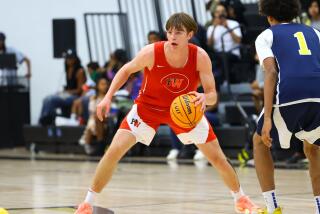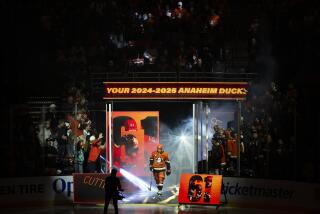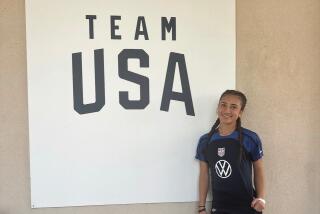Junior Mint
Tim Kraus received the finest compliment an American hockey player can get, at least from a Canadian.
Kraus, a 17-year-old left wing from Garden Grove, made his way to the Great White North with hopes of forging a professional hockey career. He is among a group of born-and-bred Southern California teens playing in the Canadian major junior leagues, the main talent feeder into the NHL.
Through his first days at training camp, Kraus went about his work without any of his Vancouver Giants’ teammates knowing that his hockey roots were palm trees, not Douglas fir. Then a local newspaper wrote about his background.
“The guys were all kind of shocked,” Kraus said. “They found it hard to believe I was from California. They were telling me, ‘You’re so good we thought you were Canadian.’ They just thought it was strange that a kid from Southern California was playing hockey.”
People may have to get used to the idea.
It has been 16 years since Wayne Gretzky -- Canada’s national hockey treasure -- was traded from Edmonton to the Kings in a deal that altered the region’s hockey landscape. When he arrived, youth hockey in Southern California consisted of scattered teams playing at precious few ice rinks. That has changed dramatically.
Canadian major junior teams -- as well as American college programs -- now scout the area regularly, looking for talent from the numerous teams playing at the ice rinks that sprouted after Gretzky’s arrival. There are a handful of Southern California players in Canada this season, including forward Ray Macias, who was the Kamloops Blazers’ rookie of the year this season.
USA Hockey has also received a push. Billy Blase, Donald Inman and John Kemp are with the under-17 national team. They were plucked from beach towns and valley malls, giving Southern California three of the 25 team members, an unheard-of ratio.
Meanwhile, Gabe Gauthier, Brett Sterling and Robbie Earl, all products of USA Hockey’s national team development program, are among Southern California players who have parlayed their abilities into successful college careers.
“Southern California is becoming a very aggressive market for us,” said Randy Hansch, the director of player personnel for Kamloops, a Canadian major junior team. “Ten years ago, no one cared about what was going on down there. Now you have to scout the area. It has gotten to the point where there are a large number of talented kids down there.”
*
Gauthier, a 20-year old sophomore from Buena Park, is the leading scorer for the University of Denver, which will play Minnesota Duluth in the Frozen Four, an NCAA semifinal, today. He has 17 goals and 42 points.
“Sometimes it seems amazing even to me that I’m a Southern California kid playing hockey,” said Gauthier, who played for the South Coast Sabres. “I’ll get guys telling me, ‘No way, you’re not a hockey player, you’re a surfer or something.’ ”
Sterling, a member of the USA team that won gold for the first time at the 2004 World Junior Championships, has led Colorado College in goals his first two seasons and was a fifth-round pick of the Atlanta Thrashers in June. Earl had 14 goals as a freshman to help Wisconsin reach the second round of the NCAA playoffs this season.
No one is ready to dub Los Angeles as the new “Hockeytown” just yet. The sport is still more cult than culture, downplayed in the media and ignored by many. Still, there are 29 prominent youth hockey programs -- each with five age-group divisions -- from San Diego to Bakersfield, some with as many as 14 teams.
The California Wave’s Midget AAA (14 and up) won the national championship last season and finished second this year. The Los Angeles Stars had a midget team place second in the prestigious Mac Tournament in Calgary, Canada, in January, losing to perennial powerhouse Shattuck (Minn.) St. Mary’s in the final.
“The Canadian teams still think it’s going to be a cakewalk when they play Southern California teams,” said Al Patterson, director of operations for Global Sports Camp, which runs an invitation-only camp in Vancouver. “They still have that mental picture. The reality is, those California teams are winning more than their share of games.”
*
Ken Martele, director of player personnel for the United States’ national team development program, was reared playing hockey in the Southland. He attended Lake Superior State University, where he was part of a national championship team in 1988. Yet, he said, the growth of hockey in Southern California was stunted for several years.
“There was actually a crop of pretty good players that came out of California in the 1970s,” Martele said. “But after the group I was in went through, a lot of rinks started closing.”
Then Gretzky was traded to the Kings in 1988. The Kings made the 1993 Stanley Cup finals. The Mighty Ducks began play the following season.
“Wayne Gretzky shows up and the popularity increased, more rinks are built,” Martele said. “It takes years to have an effect, but once you have the facilities, you have the opportunities.”
This has been coming for the last decade, hockey proponents say. As the NHL flew south, setting up shop in the Sun Belt -- Dallas, Nashville, Tampa -- youth interest in those areas grew. This year, the USA national team development program brought in a player from Texas for the first time.
Southern California, though, has blossomed like no other sun-drenched region. More rinks meant more players. That lured better coaches.
“We started to get some respect and were able to get in some better tournaments,” said Brian Schoenle, a midget coach with the Los Angeles Stars and a scout for Oshawa of the Western Hockey League. “People started to pay attention to our kids. It was a slow climb, but in the last six or seven years there has been a major difference.”
There have been a handful of NHL players with Southern California ties, even a few that qualify for the elite category. Detroit Red Wing defenseman Chris Chelios, a future Hall of Famer, spent his early years in San Diego. Peter McNab, who scored 363 goals in 14 NHL seasons, played hockey in San Diego.
Noah Clarke, who is from La Verne, this season became the first Southern California-born player to play for the Kings. But in the past, the few players who showed exceptional hockey skills were usually shipped east to hockey hotbeds at a young age.
At 13, the Minnesota Wild’s Richard Park moved from Rancho Palos Verdes to Toronto. “People looked at me like I was from a different planet,” he said.
The improvement of the area’s midget teams means a player has less reason to rush off to frozen lands. Kraus, Macias and Nathan Grochmal, another a Kamloops defenseman, all played for area midget teams before heading north.
“When you get kids like that, jumping to juniors out of midget programs, you know the quality of program they’re coming from is high,” Patterson said. “Junior teams would have to be crazy not to be scouting Southern California.”
While Canadian teams are discovering there is talent down south, players here are discovering they can play up north.
“Ray [Macias] and I were drafted by Kamloops last year, but we thought no way are we ready for that,” said Grochmal, who is from Yorba Linda. “We went up there for camp this year, and we found out we were ready.”
Grochmal, a defenseman, speaks in a giddy tone describing the first few days that he and Macias were with Kamloops.
“Everybody was saying, ‘Who are these guys coming from California? They don’t play hockey down there,’ ” Grochmal said. “It was kind of cool to prove to them that we do play hockey down in Southern California and we can play with the best Canadians.”



